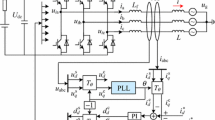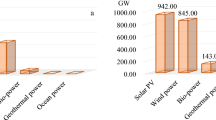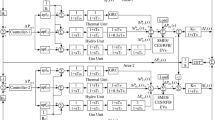Abstract
This paper investigates the impacts of large synchronverters (SV) integration on transient stability and strength of electric power systems. Large Synchronverters account for large amounts of electrical energy injected into the power grid through power converters, as in PV and off shore wind power sources. Potential stability problems may occur when large power converters are connected to weak power systems (PES). An SV is an inverter that mimics a synchronous generator (SG). Methodologically, the SV performances are contrasted to the standard SG of like parameters in terms of system strength and transient stability. These criteria are quantified respectively by the Short-circuit Ratio (SCR) and the critical clearing time (CCT). The penetration ratio of SV generation is increased to the detriment of SG power. Due to their current controllers’ limitations, the SV participation in short-circuit currents is reduced to nominal values, diminishing the network strength. Although SVs have similar properties as SGs and have variable virtual inertia, this study reveals many limitations that must be taken into account when planning their integration into the network. In opposition, SGs enhance the transient stability margin even in weaker systems. Hence, strong buses in a PES indicated by large SCR and CCT feature larger amounts of SG power compared to the power generated by SVs.
Access this chapter
Tax calculation will be finalised at checkout
Purchases are for personal use only
Similar content being viewed by others
References
Urdal H, Ierna R, Zhu J, Ivanov C, Dahresobh A, Rostom D (2015) System strength considerations in a converter dominated power system. IET, Renew. Power Gen 9(1):10–17
Gavrilovic A (1991) AC/DC system strength as indicated by short-circuit ratios. In: International conference on AC and DC power transmission, September 17–20, 1991, pp 27–32
Jia C, Wen J, Bie X (2012) Study of the effect of AC system strength on the HVDC startup characteristics. In: International conference on sustainable power generation and supply, September 8–9, 2012
D. Wu, G. Li, M. Javadi (2018) Assessing impact of renewable energy integration on system strength using site-dependent short-circuit ratio. IEEE Trans Sustain Energy 9:1072–1080
Zhang Y, Huang SH, Schmall J, Conto J, Billo J, Rehman E (2014) Evaluating system strength for large-scale wind plant integration. In: IEEE power and energy society general meeting, July 2014, pp 1–5
Huang SH, Schmall J, Conto J, Zhang Y, Li Y, Billo J (2015) Voltage stability of large-scale wind plants integrated in weak networks: an ERCOT case study. IEEE power and energy society general meeting, July 2015, pp 1–5
Nkechi AI, Howlader AM, Yona A (2018) Integration of photovoltaic energy to the grid, using the virtual synchronous generator control technique. J Energy Power Eng 12:329–339
Zhong Q-C, Weiss G (2011) Synchronverters: inverters that mimic synchronous generators. IEEE Trans Ind Electron 58(4):1259–1267
Aouini R, Marinescu B, Ben Kilani K, Elleuch M (2016) Synchronverter-based emulation and control of HVDC transmission. IEEE Trans Power Syst (1):278–286
Aouini R, Nevzi I, Ben-Kilani K, Elleuch M (2016) Exploitation of synchronverter control to improve the integration of renewable sources to the grid control. J Electr Syst 12–3:515–528
Nguyen P-L, Zhong Q-C, Blaabjerg F, Guerrero J-M (2012) Synchronverter-based OPERATION OF STATCOM to mimic synchronous condensers. In: 2012 7th IEEE conference on industrial electronics and applications (ICIEA)
Kundur P (1994) Power system stability and control. Mc Graw-HillInc
Callavik M, Blomberg A, Häfner J, Jacobson B (2012) The hybrid HVDC breaker—aninnovation breakthrough enabling reliable HVDC grids, Technical Paper, ABBGrid Systems
Author information
Authors and Affiliations
Corresponding author
Editor information
Editors and Affiliations
Rights and permissions
Copyright information
© 2021 Springer Nature Singapore Pte Ltd.
About this paper
Cite this paper
Aouini, R., Ben Kilani, K., Elleuch, M., TRAN, Q.T. (2021). Large Synchronverter Integration in Power Electrical System: Impacts on SCR and CCT. In: Bououden, S., Chadli, M., Ziani, S., Zelinka, I. (eds) Proceedings of the 4th International Conference on Electrical Engineering and Control Applications. ICEECA 2019. Lecture Notes in Electrical Engineering, vol 682. Springer, Singapore. https://doi.org/10.1007/978-981-15-6403-1_16
Download citation
DOI: https://doi.org/10.1007/978-981-15-6403-1_16
Published:
Publisher Name: Springer, Singapore
Print ISBN: 978-981-15-6402-4
Online ISBN: 978-981-15-6403-1
eBook Packages: Intelligent Technologies and RoboticsIntelligent Technologies and Robotics (R0)




